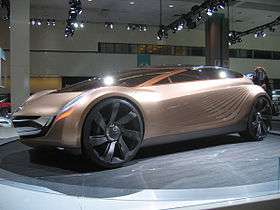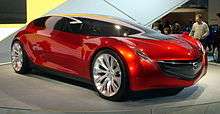Mazda Nagare (car design)
| Nagare | |
|---|---|
| Overview | |
| Manufacturer | Mazda |
| Production | 2006-2007 |
| Designer |
Franz von Holzhausen Laurens van den Acker |
| Body and chassis | |
| Class | Concept car |
| Related |
Mazda Nagare Mazda Ryuga Mazda Hakaze Mazda Taiki Mazda Furai |
| Powertrain | |
| Engine |
Mazda MZR engine Mazda Wankel engine |
| Chronology | |
| Successor | Kodo design language |
Nagare is a series of designs made by Franz von Holzhausen and Laurens van den Acker for Mazda. These designs have been constructed into concept cars, starting with the car of the same name, which then started this design series. The Nagare design lineup is a showcase of what Mazdas may look like in 2020.
The Nagare design became popular after the release of the Mazda Furai. It was ditched in 2011, and Mazda started with the Kodo design.[1]
Influences in design
The influence of the designs are wind and flow.[2]
These can be seen in the cars' design, where some areas have the flowing motion. Some of Mazda's production cars had these as well (e.g. the 2010 Mazda3 Grand Touring).
Vehicle nomenclatures
All vehicles have names in which represent the "wind and flow" inspiration in one way or another.
Engine usage
The particular engines used for the cars were the Mazda MZR straight-four and the Wankel rotary.
The MZR was used on the Ryuga and Hakaze, while the Wankel was used on the Taiki and Furai. The Nagare's engine is non-existent as it is not a running prototype.[3]
Concept cars


Mazda Nagare
The Mazda Nagare is the first car built under the Nagare design series, and takes the same name as the series, which makes the car the only one to do this in the Nagare series. The car debuted in the 2006 LA Auto Show.[3]
The car's body style is based on a sports car. The design has the look of a long-wheelbase hatchback. The interior is very irregular, with the driver placed front and center under the roof's highest point, and three additional passengers seated behind in a "wrap-around lounge". The doors lift upwards while also pushing out sideways. The interior also has the futuristic look.
Designer Franz von Holzhausen mentioned during an interview at Autoblog, that he took inspiration from nature and pasted it onto the Nagare concept.[3] Some of von Holzhausen words are typed below:
"We began by studying motion and the effect it has on natural surroundings: how wind shapes sand in the desert, how water moves across the ocean floor, and the look of lava flowing down a mountainside. Natural motion registers an impression in your brain and that's what we hoped to capture with the new Nagare surface language. Once we started sketching our ideas, we weren't surprised to find similar quests underway in other product design disciplines. We found examples of motion influencing the shape and surface of furniture, architecture, apparel, and artwork. Nagare undoubtedly proves our confidence in identifying a new and exciting visual language for Mazda as we lead the way in defining the interaction of motion and flow in automobile surfacing."
Mazda Ryuga
The Mazda Ryuga is the second vehicle built under the Nagare series.
The Ryuga name means "gracious flow", which references the design purpose. The car features gull-wing doors, and an entirely futuristic interior, hinting Mazda's future in automobiles. A MZR straight-four engine runs the car, at the size of 2.5 liters.[4]
Mazda Hakaze
The Mazda Hakaze is the third car to be featured in the series. The name stands for "leaf-wind".
The car is based on a crossover body style. The car has scissor doors, which makes front and rear access easy. HVAC and radio controls are difficult to access, making it unfriendly; the seats are very pod-like, hinting the seats may be hooked onto the center console. Mazda says the car is more production-ready than the rest of the lineup.[5]
Mazda Taiki
The Mazda Taiki is the fourth vehicle featured in the series.
The name Taiki means "atmosphere", which is fitting, noting the car's atmospheric-like top. The rear wheels are set out from the body, and an all-glass canopy goes around the driver and passenger. The car's interior continues the flowing design theme. Power from the Taiki comes from an improved version of the Mazda RX-8's Renesis Wankel engine.[6]
Mazda Furai
The Mazda Furai is the fifth and final car in the series. It is also the most storied and most popular Nagare-styled car.
The Furai is based on the Courage C65 LMP2 race car that Mazda had used for the American Le Mans Series.[7] The car runs on E100 ethanol and is the only rotary-powered car to do this. The engine is a mid-mounted R20B Renesis rotary engine pushing out 450 hp (336 kW; 456 PS). This power is delivered to the rear wheels by a 6-speed Xtrac semi-automatic transmission. The engine was built by company Racing Beat, who also made the rotary-designed muffler.[7]
The name Furai is also a reference to the "wind and flow" Nagare design inspiration, which means "sound of the wind". The car wears the number #55, to give tribute to the Mazda 787B.
The car was tested in many circuits, such as Mazda Raceway Laguna Seca. In 2008, the car had died off in eight minutes after it was set on fire during a Top Gear photoshoot. This event was fully exposed in 2013.[8][9]
References
- ↑ Patton, Phil (2011-05-20). "Mazda Designers Abandon Nagare, Embrace Kodo". The New York Times. ISSN 0362-4331. Retrieved 2017-06-12.
- ↑ "Mazda Nagare design language - Car Body Design". www.carbodydesign.com. Retrieved 2017-06-12.
- 1 2 3 Neff, John. "LA Auto Show: Mazda Nagare Concept wedges into the spotlight". Autoblog. Retrieved 2017-06-12.
- ↑ "Mazda Ryuga news - Detroit show: Mazda Ryuga Concept - 2007". Top Gear. Retrieved 2017-06-12.
- ↑ Kaehler, Justin (2007-03-01). "Mazda Hakaze". IGN. Retrieved 2017-06-12.
- ↑ Holmes, Jake. "Mazda Taiki Concept". CarandDriver. Retrieved 2017-06-11.
- 1 2 "Mazda Furai". www.racingbeat.com. Retrieved 2017-06-12.
- ↑ "Exclusive: how the Mazda Furai burned to death". Top Gear. Retrieved 2017-06-12.
- ↑ Mikeado. "The Mazda Furai Burned To Death In 8 Minutes, Hidden From Help". Oppositelock. Retrieved 2017-06-12.